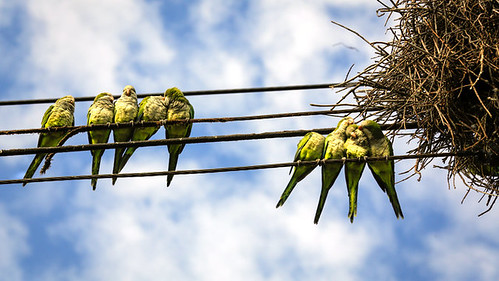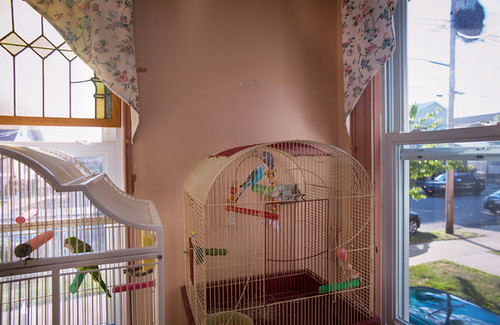Resilient Monk Parrots Flock to Queens and Beyond
 Tuesday, September 16, 2014 at 13:36
Tuesday, September 16, 2014 at 13:36  A nest of monk parrots near the home of Liz Lynch in Queens. Image by Ángel FrancoStuck with two cockatiels and a lonesome love bird in a cage in Liz Lynch’s sunroom in Howard Beach, Queens, Elvis the parrot seems like just another ordinary pet shop purchase.
A nest of monk parrots near the home of Liz Lynch in Queens. Image by Ángel FrancoStuck with two cockatiels and a lonesome love bird in a cage in Liz Lynch’s sunroom in Howard Beach, Queens, Elvis the parrot seems like just another ordinary pet shop purchase.
But outside Ms. Lynch’s windows are signs that he is not: There is the nest atop a utility pole he fell from last year, and there is Kennedy International Airport, the destination for Elvis’s forebears, imported in crates to be sold as pets.
“They would get out of the terminals where they were shipped,” said Ms. Lynch, 60, whose father worked at the airport, “and they adapted.”
Young Elvis, who has a permanently disabled wing, is among the latest generation of monk parrots to take root in Queens, a borough known to embrace those from other shores.
Queens is not the only place the tropical-green birds have become firmly entrenched. Fifty years after exotic-bird importers began carting them here, the parrots have nestled into other neighborhoods in the city and beyond. The best guess on their citywide population is around 550, though biologists say bird counts often capture just a tenth of their true totals. The parrots have set up colonies in at least 10 states, including Florida, Texas, Illinois and Oregon. They dappled European skies, breeding in England and Spain.
 Elvis, left, is among the latest generation of monk parrots to take root in Queens. Image by Ángel Franco“Chances are they’ve got inroads in Asia that we just don’t get reports of,” said Frank W. Grasso, a scientist at Brooklyn College who has studied the parrots for 12 years. “They have a kind of resilience that allows them to colonize lots of locations, a lot like human beings.”
Elvis, left, is among the latest generation of monk parrots to take root in Queens. Image by Ángel Franco“Chances are they’ve got inroads in Asia that we just don’t get reports of,” said Frank W. Grasso, a scientist at Brooklyn College who has studied the parrots for 12 years. “They have a kind of resilience that allows them to colonize lots of locations, a lot like human beings.”
But they clearly feel at home in Queens. They have raised their young here. Survived epic storms. And steadily increased their numbers.
“When the sun starts coming up, you hear them chirping and chirping,” Stanley Rea, 58, said as he made his predawn rounds delivering newspapers last week on the street where Elvis lives.
“The way they build their nests is amazing,” Mr. Rea said. “They pluck branches from one tree and they fly to their nests and they set them in there. It’s pretty cool.”
Ornithologists think so too.
Of 320 parrot species worldwide, the monks — so named for the way their gray-and-green plumage paints a hood over their heads — are the only ones that forgo tree hollows to build their own nests: huge, multichambered shelters people compare to condominiums. They live there all year long. They have a capacity to mimic, but mostly call to one another in a high-pitched chatter that can rattle people’s nerves. They can live for 30 years.
Of the roughly 30 species of parrots now breeding in the United States, only monks colonize in colder climates, and thus are “the only ones in New York City,” said Stephen Pruett-Jones, a professor of ecology and evolution at the University of Chicago, who has studied them in Hyde Park for 25 years.
The first published citing of the species (Myiopsitta monachus) in the wild in America was in New York in 1967, he said. Newspaper accounts put them in Chicago the following year, and in Florida.
By 1970, there was the odd parrot sighting in New York: a few at Riis Park, a handful in the Rockaways, some more on Staten Island. A nest, but no birds, was found in Central Park, in a broken floodlight behind the Metropolitan Museum of Art.
Their locations were pinpointed, but it was less clear how they got here. No biologist believes they flew here on their own.
Some take Ms. Lynch’s view: They escaped from the airport. Others see less swashbuckling beginnings: Owners sick of their rasping cries set them free. Marc Morrone, who owns Parrots of the World, a pet store in Rockville Centre, on Long Island, says neither explanation is valid. The airport story is an “old wives’ tale,” he said, because shipping containers do not tend to break, and the birds make “wonderful” pets, so why would anyone set them free?
Besides, he said, monk parrots that have lived in the wild are not the same as the pet store variety. “The ones we sell as pets are domesticated,” Mr. Morrone said. “They don’t think like the wild birds do. They are smaller than the wild birds. With a domesticated animal, we control its genes.”
Indeed, the wild parrots, with their acute social skills, have expanded their turf, locally and nationwide, said Dr. John W. Rowden, an ornithologist with the National Audubon Society, who cited data from the organization’s Christmas bird count.
The nest atop a utility pole in Howard Beach that Elvis fell from. Credit Ángel Franco/The New York Times
 The nest atop a utility pole in Howard Beach that Elvis fell from. Image by Ángel FrancoToday in Brooklyn, their pile-of-twig nests are built in the iron gates of Green-Wood Cemetery. They have made homes in Upper Manhattan and amid the trees in Riverside Park. They are in Whitestone and Flushing, Queens. They have built nests in Edgewater, N.J., in the slopes along River Road, an undulating bicycle path in the shadow of the George Washington Bridge, said Corey Finger, of Forest Hills, Queens, a co-owner of 10,000 Birds, a birding blog.
The nest atop a utility pole in Howard Beach that Elvis fell from. Image by Ángel FrancoToday in Brooklyn, their pile-of-twig nests are built in the iron gates of Green-Wood Cemetery. They have made homes in Upper Manhattan and amid the trees in Riverside Park. They are in Whitestone and Flushing, Queens. They have built nests in Edgewater, N.J., in the slopes along River Road, an undulating bicycle path in the shadow of the George Washington Bridge, said Corey Finger, of Forest Hills, Queens, a co-owner of 10,000 Birds, a birding blog.
But Queens has extended the birds perhaps the biggest welcome.
State Senator Joseph P. Addabbo Jr., who can see one of their nests from the windows of his district office in Howard Beach, is pushing two bills he introduced in 2010 to protect the parrots (also known as parakeets), though neither has passed in Albany. One would put them in a protected category. The other would require their nests be handled with care if they have to be moved. The senator says seeing the “green, rather large, rather unique-sounding parakeet” among pigeons fascinates New Yorkers.
However, not everyone is as enamored of them. In Argentina, “they are reported to be an agricultural pest,” Dr. Pruett-Jones said.
In this country, they are considered a “nuisance species,” he said, and have caused economic trouble in Florida, Texas and elsewhere because they build nests around heat-emitting transformers atop utility poles. Several states, including California, have outlawed parrot breeding and importing them as pets.
In New York, too, nests have caused transformers to catch fire, said Michael S. Clendenin, a spokesman for Con Edison. But crews that service the power lines now take extra care.
“They’ve learned to work around them,” Mr. Clendenin said. “If there are chicks or eggs in there, they’ll hire a contractor to take it down appropriately.”
The ready heat supply has helped the parrots survive in New York as well as backyard gardens, the parrots’ smorgasbord. They eat grass blades, dandelion seeds, holly berries, native leaf and fruit buds or suburban ornamental fruits like crab apples. In the winter, they help themselves at backyard bird feeders. They feed their young insects.
On 99th Street in Howard Beach — a street along a canal leading from Jamaica Bay — Mr. Rea said there seemed to be fewer pests since the parrots gained a foothold.
As Mr. Rea drove, he passed several nests, including the one Elvis lived in until a year ago, when Alex Breviario, 34, discovered him limping in the street beneath his nest, scooped him up and gave him to Ms. Lynch.
As Ms. Lynch told Elvis’s story, she recounted her father’s tale of finding a crate full of parakeets on an airport road. He took it home. The following Monday he returned it, but not before Ms. Lynch let the birds out to fly all over the house for the weekend. (She is careful to say that they were all rounded up and put back in the crate.)
“They got here from J.F.K.,” Ms. Lynch said. “That’s how they started.” If her father found one crateful of parrots gone astray, there had to be other such mishaps. Friends who worked at Pan Am tended to have escaped parrots as pets, she said.
Elvis, in his cage by the windows facing his relatives in the nest outside, was speaking, too.
“He calls to them,” Ms. Lynch said. “They talk to him. And if he’s in a mood, he won’t stop.”
 Myiopsitta monachus - Monk Parakeet | in
Myiopsitta monachus - Monk Parakeet | in  Urban parrots
Urban parrots 
